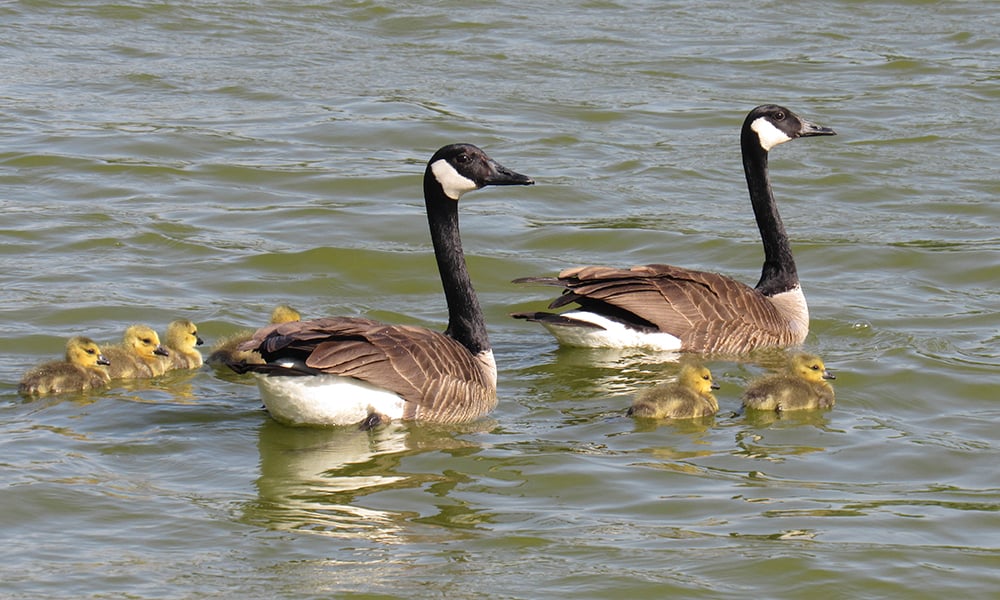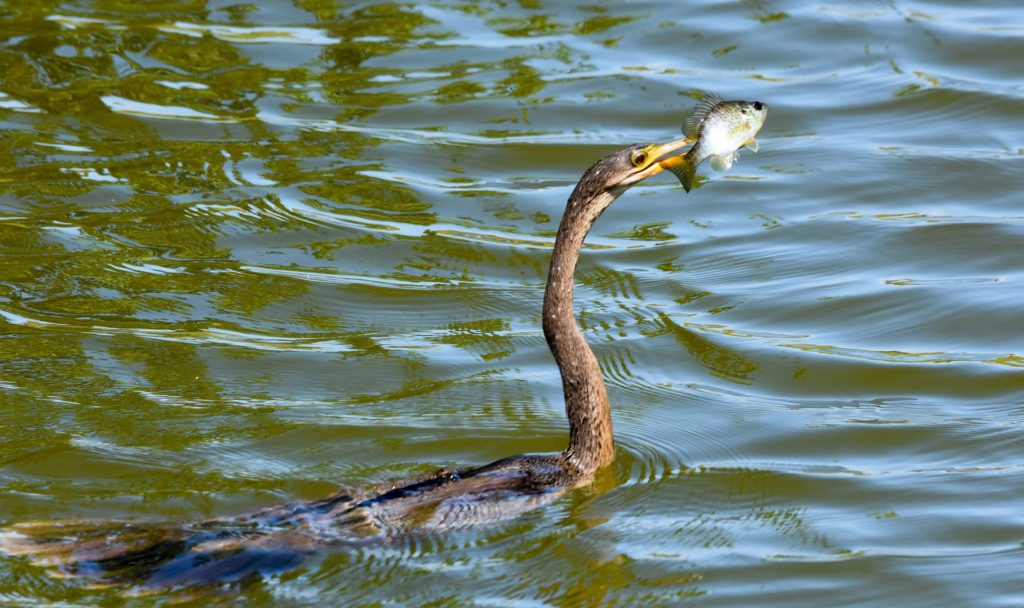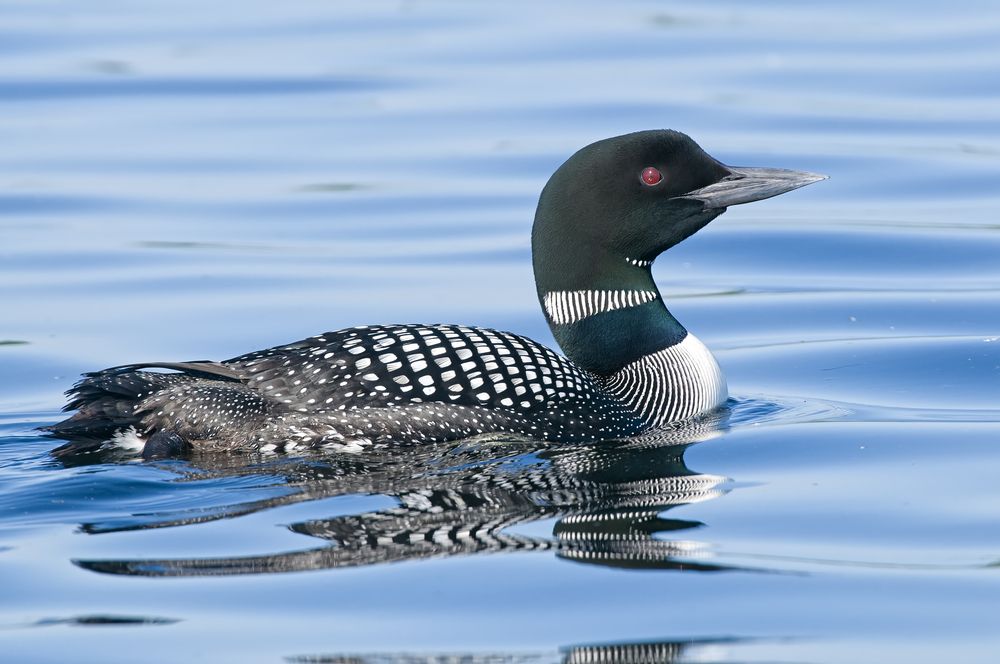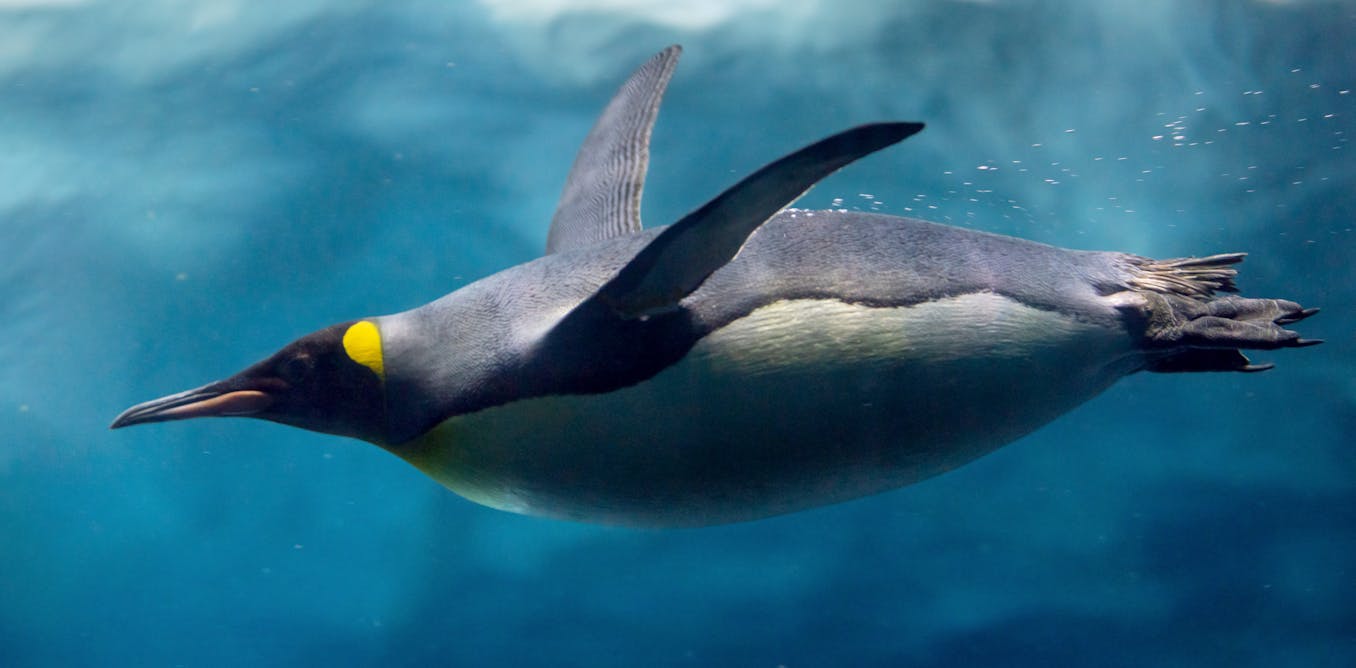As a birdwatcher, you might have come across the term “water birds” every now and then. These are the birds that have a primarily aquatic lifestyle: they inhabit areas in or around water bodies (both freshwater and saltwater ecosystems) and are dependent on aquatic (or marine) life for their nutrition.
The large umbrella of waterbirds covers a wide range of bird families, such as
- Marine birds like penguins, auks, and petrels
- Shorebirds like plovers, avocets, and sandpipers
- Waterfowls like ducks, swans, screamers, and geese
- Other birds like flamingos, herons, storks, kingfishers, rails, ibises, and so on.
While all these birds are adapted to live in or around water, only some of them have mastered the skill of swimming or spending time underwater. Are you wondering which birds are those? Let’s find out.
Here are 12 birds that are capable of swimming underwater:
- Ducks
- Geese
- Swans
- Anhingas
- Pelicans
- Loons
- Dippers
- Cormorants and Shags
- Grebes
- Coots
- Penguins
- Auks
In this article, we will learn in-depth about all the birds that can swim underwater and explore how they can do it.
Ducks (Anatidae)

Of all the waterfowl families that belong to the Anseriformes, the duck family is the largest and most diverse. There are about 150 duck species in the world, divided into 7 subfamilies and 41 genera. These birds also have the most widespread population globally and can be found on every continent except Antarctica.
While most duck species spend a majority of their lives in water bodies, not all of them are capable of swimming or diving underwater. The duck species that fulfill this criterion belong to the family of the Diving ducks.
All diving duck species belong to the tribe Aythyini, in the subfamily Anatinae. These ducks have been named so because of their tendency to catch their prey by diving underwater. They dive underwater by propelling their feet, which are placed further back in their body for a convenient dive.
Swans (Genus: Cygnus)

Admired universally for their beauty and grace, the swans are the largest members of the entire Anatidae family. These long-necked waterfowls far surpass the ducks and geese in body length, weight, and wingspan.
Swans are adapted to live both on land and in water. While in water, these birds generally float on the surface instead of diving underwater. Because of their long necks, the swans can easily catch their prey underwater while remaining afloat on the surface, unlike their cousins, and have no need to dive underwater.
However, on some rare occasions, swans have been reportedly seen diving underwater, which means they are capable of it.
Geese (Genera: Branta, Anser)

Closely related to the ducks and swans, geese are another group of birds within the Anatidae family. These loud birds are taller than ducks but shorter than swans and have 17 extant species in the world.
Just like swans, geese also possess long necks that they use to grab fish or other aquatic vegetation from under the water surface. These birds enjoy floating on the surface of lakes and rivers and are only known to dive underwater when they face a threat or are trying to escape.
Anhingas (Anhinga anhinga)

Belonging to the family of the darters, the Anhingas are a species of tropical waterbirds that inhabit warm regions with shallow water. Because of their widespread population, these birds have two subspecies occurring in different geographical locations.
The diet of the Anhingas consists almost exclusively of medium-sized wetland fish, in addition to tadpoles, water snakes, shrimp, crabs, and crayfish. And in order to catch their prey underwater, these birds possess a long-stretching, S-shaped neck and webbed feet.
They also have dense bones and a neutral buoyancy in water which allows them to submerge fully inside a water body and hunt down their prey. For this reason, they’re also referred to as “Water Turkeys.”
Pelicans (Pelecanidae)
/148094454-56a008725f9b58eba4ae8f43.jpg)
Pelicans are a family of large wading birds with a remarkable gular pouch attached to their lower mandibles. There are 8 extant pelican species in the world, and 6 of them possess a predominantly pale plumage.
While pelicans are skilled fliers, their strong legs and webbed feet make them great swimmers as well. They also have preen glands that secrete oil to waterproof their feathers, further helping them to swim with ease.
Because the main diet of these birds consists of fish, crustaceans, turtles, and amphibians, they always return to water bodies to hunt for food. Many pelican species also tend to dive underwater while foraging for food.
Loons (Gaviidae)

Loons are a group of aquatic birds that are mainly found in North America, Asia, and Europe. While these birds are popular as “loons,” in the United Kingdom, they’re referred to as “dippers.
The family of loons consists of 5 species, all of which are skilled at both flying and swimming. However, when it comes to walking on land, these birds face difficulties and walk awkwardly.
It is because their feet are placed at the far back of their bodies to be used to propel themselves underwater. Scientists have reported that these birds can hold their breath underwater for about 90 seconds.
Dippers (Cinclidae)
Have you ever heard of a passerine bird that can swim underwater? If not, let me introduce you to dippers, a group of tiny passerine birds capable of swimming and diving underwater.
These birds have been named after their tendency of bobbing continually. Although they’re small, their bodies are rather stout, with a short tail that points upwards. Their wings are short as well, along with relatively long and powerful legs.
Dippers are found in a variety of freshwater habitats in Europe, Asia, and the Americas. They prefer to dwell on the banks of fast-moving rivers in their breeding months. However, during winters, you might even find them in coastal areas.
While the dippers don’t possess webbed feet to help them swim underwater, they do have other adaptations that help them with it. Their short wings have strong muscles underneath that they can use as flippers underwater. They also have a large preen gland that secretes oily substances to waterproof their plumage.
Furthermore, dippers also have highly developed focus muscles to enhance their underwater vision and nasal flaps that keep water out of their nostrils. Lastly, their blood has a higher hemoglobin capacity than most birds, enabling them to stay underwater for about 30 seconds.
Cormorants and Shags (Phalacrocoracidae)

Cormorants and shags are a family of medium-to-large-sized aquatic birds with predominantly dark plumage and a long, hook-tipped bill. These birds have fully webbed feet that help them in diving underwater to catch fish, which are the central part of their diet.
While cormorants and shags are known to dive, propelling their feet, they also take the help of their wings in the process. Being excellent divers, these birds can dive up to 45 meters inside the surface of the water.
Grebes (Podicipediformes)

Grebes are an order of aquatic birds that have a widespread distribution in the world, consisting of 22 species divided into 6 different genera. These medium-to-large-sized birds are generally found in freshwater habitats but can also migrate to seawater during the winters.
Grebes are narrow-winged birds that are more inclined towards diving than flying; two grebe species are completely flightless. They possess lobed toes that might not help them walk but are highly useful in diving.
When you look at the grebes for the first time, they will seem to be closely related to the ducks. But according to some recent studies conducted on them, the scientists found that they are closely related to the flamingoes. Grebes and flamingoes have several features in common, and you cannot find these in any other bird.
Coots (Genus: Fulica)
Coots are another genus of birds that look quite like the ducks in appearance but have a predominantly dark plumage that sets them apart from the latter. In truth, they’re closely related to the rails and gallinules and belong to the Rallidae family. There are 9 extant species of coots in the world, all of which belong to the Fulica genus.
Some of the remarkable physical features of the coots include a white frontal face shield and strong legs with lobed toes, which helps them with diving underwater as well as walking and running. On the other hand, these birds are weak fliers and possess short, rounded feathers.
Being omnivores, coots primarily feed on plant materials but will occasionally eat fish, eggs, and other small animals.
Penguins (Sphenisciformes)

Penguins are a large family of flightless aquatic birds with exclusive distribution in the southern hemisphere, with only one exception (Galapagos Penguins). These birds are some of the most well-adapted birds for aquatic life.
Their counter-shaded coloration, webbed feet, and wings evolved into flippers, which all benefit them to dive underwater. Research shows that they spend half their lives on land and the other half in the sea.
Auks (Alcidae)

Distantly related to the penguins, the auks are a family of small aquatic birds. In their appearance and coloration, auks resemble penguins. However, unlike the latter, auks are capable of flight and are great swimmers as well.
The alcid family includes various birds like murrelets, murres, auklets, guillemots, and puffins. Altogether, there are 24 extant species in the family, divided into 2 subfamilies and 6 tribes.
While auks can fly effortlessly, when they enter a water body, their behavior is very much similar to that of the penguins. Just like them, the auks are also wing-propelled divers. Like all other seabirds, they also feed on fish and other marine creatures and dive underwater to catch their prey.
Conclusion
With this, we come to the end of this article. Today, we’ve learned that while we generally associate birds with the sky, that’s not all they can do. There are many birds in the world that are also great divers and spend a primarily aquatic lifestyle.
While some of these are waterfowls and are adapted for life around the water bodies, there are also exceptions like the dippers, which are not water birds but still enjoy a dive in the river. Lastly, there are also birds that are flightless or weak fliers but can swim and dive exceptionally well.



